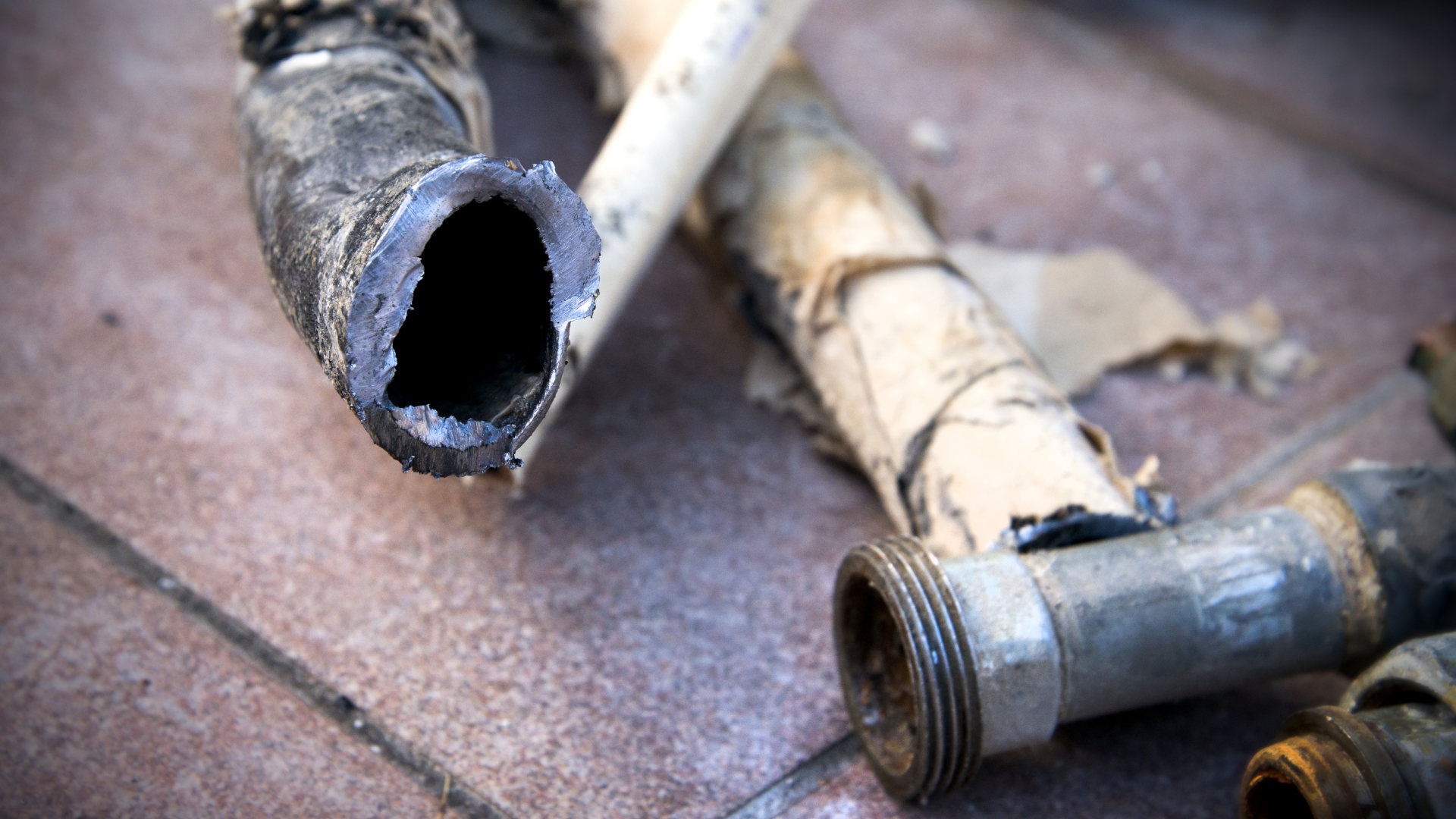Fresh Insights Into the Stubborn Problem of Lead Water Pipes
Ashburn is a largely middle-class, predominately African American, Hispanic, and Latino community on Chicago’s far Southwest Side. The community borders two neighboring suburbs and is known for its high rate of home ownership and its many Cape Cod, ranch, and bungalow houses.
Chakena Sims owns and resides in one of these homes in Ashburn with her family. She was raised in Chicago and recalled one key lesson she learned at a young age: Don’t trust the tap water.
Particularly in Black communities, “there has been a historic distrust amongst a lot of us around the quality of our tap water,” said Sims, now a senior policy advocate focused on safe drinking water issues at the Natural Resources Defense Council and a former commissioner of the Metropolitan Water Reclamation District of Greater Chicago. “There are some unspoken truths that we’ve already engaged in early on,” she continued. “So whether that prompts us to buy bottled water in place of using our tap, these are things we’ve inherently known.”

Chakena Sims is a senior policy advocate at the Natural Resources Defense Council and a former commissioner of the Metropolitan Water Reclamation District of Greater Chicago. After Sims discovered her home had lead service lines in 2023, she installed a filter certified to remove lead.
Visual: Robert Bates Photography
Indeed, there is an unseen danger in the plumbing. Sims’ family home is one of hundreds of thousands across Chicago using tap water delivered by lead service lines — the intake pipes that connect municipal water mains into houses and apartment buildings. As they age, these pipes — recently mapped as part of a report by Inside Climate News, WBEZ, and Grist — can release lead into the home’s water supply, particularly when the water has high acidity.
There are no safe levels of lead exposure. Even low levels pose a risk, especially for children, who can experience developmental delays, learning disabilities, and other problems. In adults, chronic exposure can result in cardiovascular problems, high blood pressure, kidney damage, difficulty concentrating, and more.
Despite a federal ban on the use of lead pipes in new plumbing systems in 1986, the Environmental Protection Agency estimates there are still more than 9 million lead service lines across the United States. Many of these lead pipes connect to older buildings in lower income communities of color with aging infrastructure in cities such as Chicago, Milwaukee, and New York.
The problem is most serious in Chicago, where the city mandated lead service lines until 1986. As a result, Chicago now has the most lead service lines in the country. About 400,000 of these pipes, which serve more than 2.7 million residents in the city, are still delivering water to homes and apartment buildings.
Despite a federal ban on the use of lead pipes in new plumbing systems in 1986, the Environmental Protection Agency estimates there are still more than 9 million lead service lines across the United States.
Policymakers, researchers, and environmental advocates are hopeful the $15 billion earmarked by the Biden-era Bipartisan Infrastructure Law can replace many of the country’s lead service lines. Last year, the EPA passed a rule that set 2037 as the deadline for most water systems to replace all of their lead water pipes. But the agency is giving Chicago until 2047 to complete the replacements. Other reporting indicates that it may take the city an additional three decades, meaning the work wouldn’t be wrapped up until 2076 .
That timeline is unacceptable, said Sims, leaving generations of mostly African American children “stuck in a vicious cycle of lead exposure.”
At the same time, there has been progress in other communities. About 90 miles north of Chicago, Milwaukee officials recently announced that about 10,000 of the city’s residential lead service lines have been replaced, with 65,000 left to go. And in Flint, Michigan, the center of a notorious 2014 water crisis that exposed an estimated 100,000 residents to lead in their drinking water, most of the city’s lead pipes have been replaced, according to a state report released in July.
Given the magnitude of the problem and the uneven progress of remediation efforts across the nation, researchers have been delving into the health and economic effects of lead exposure through water and lead pipes. Several recent papers offer fresh evidence of the numerous health effects associated with lead service lines. Public health and data scientists have also developed and trained artificial intelligence models to gauge the extent of the problem. One recent study in JAMA Pediatrics found that an alarming number of Chicago children — almost 70 percent of those under 6 years old — continue to be exposed to lead-contaminated drinking water.

Other new research reveals the extent of current water contamination in schools. One 2022 analysis of lead levels at water fountains in the Portland, Oregon, school district shows that Black and Hispanic students are exposed to more lead than White students. And in Flint, 2024 research detected decreases in math scores for schoolchildren and a greater number of special education placements — even among children living in homes with copper service lines — in the aftermath of the 2014 water crisis.
“There are so many problems out there that are so hard to fix,” said Erik D. Olson, the senior strategic director for health at the NRDC. “But pulling out a lead pipe doesn’t require rocket science.”
Beyond the health effects, the NRDC estimated that replacing all lead pipes in the U.S. could save more than $785 billion in health costs over the next three decades: “We’ve got the technology off the shelf to do it affordably, and the benefits will be felt, really forever,” said Olson.
There is no universal standard to define lead poisoning, whether from paint, water, or any other environmental source, though blood tests provide a valuable tool for monitoring lead levels in the body. Since the 1970s, the Centers for Disease Control and Prevention has lowered its threshold for elevated blood lead levels several times to its current guidance of 3.5 micrograms per deciliter (mcg/dL) or higher. That decision, finalized in October 2021, was the subject of debate because some critics believe it captures more cases than necessary, placing many more children into already overburdened case-monitoring programs — especially in lower-income communities with fewer resources.
So, for now, lead poisoning from drinking water continues to be a moving target for both residents and researchers. Benjamin Huynh, the lead author of the 2024 JAMA Pediatrics study of childhood lead exposure, was raised on Chicago’s North Side. “Growing up, this is something that I knew and a lot of people were talking about it,” said Huynh, a public health data scientist at Johns Hopkins University’s Bloomberg School of Public Health. “It seems like a lot of people knew about this. Sometimes people would complain about it, but the end result would just kind of be like, ‘OK, so what? There are lead pipes but what are we supposed to do about it?’”
One recent study in JAMA Pediatrics found that an alarming number of Chicago children — almost 70 percent of those under 6 years old — continue to be exposed to lead-contaminated drinking water.
The median childhood blood lead levels have decreased overall by more than 90 percent since the 1970s after lead was phased out or banned in gasoline, paint, and plumbing, according to the CDC. But pediatric cases persist in many urban neighborhoods, with a disproportionate number of them among lower-income, African American, and Latino communities.
Children are at the greatest risk because their bodies are still developing, said Icy Cade-Bell, a pediatrician at the University of Chicago Comer Children’s Hospital who has treated children for lead poisoning cases several times in her career. “Lead is absorbed over the gastrointestinal tract easier than it is in adults, and so, more readily than it is in adults. So, if they happen to be exposed to lead, they’re more likely to absorb that lead into their bloodstream.”
Chicago offers residents free testing kits to detect lead levels in tap water, said Huynh. The final dataset for the JAMA Pediatrics paper included more than 38,000 of these residential lead tests collected from 2016 to 2023. Huynh and his co-authors — biostatistician Elizabeth Chin at Hopkins Bloomberg and epidemiologist Matthew Kiang at Stanford University — developed a new predictive algorithm to estimate the risk of current exposure among Chicago children.
The algorithm estimated that three-fourths of the city’s blocks have lead-contaminated water, affecting some 129,000 children, or 68 percent of the city’s population under 6 years old. The research also found that almost 20 percent of these children mostly rely on unfiltered tap water.
“Seeing a number like that, it is staggering,” said Huynh.
Another key takeaway: African American and Latino residents were more likely to experience lead exposure in drinking water but less likely to have their homes tested, said Huynh. He said his team believes higher income residents are more likely to be aware of free testing resources and more likely to have free time to conduct testing at home. The researchers say that successful public health interventions require proactive outreach especially when targeting underresourced communities.
Huynh also pointed to limitations of other data available on blood lead levels. Lead tests are typically designed to capture acute, short-term exposures such as when a child ingests lead paint, he said. “Lead from water is much more insidious,” he said. “This is more like a low-level chronic exposure. So this is something you probably wouldn’t even notice on a blood level test. They’re not sensitive enough to notice this increase from a water exposure unless you’re having a really an extreme case of lead in your water.” While there are modern blood tests and can detect low-level exposure, he said, his team did not have such data to work with.
While much of the recent research on lead exposure focuses on children, most of the serious physical, mental, and cognitive effects also plague adults because the body accumulates lead over time.
According to a 2023 paper published in The Lancet Planetary Health, an estimated 5.5 million adults around the world died in 2019 from cardiovascular disease attributed to lead exposure — which can come from a variety of sources, including lead service lines. The research was conducted by a team from The World Bank.
In the 2023 NRDC issue brief on the health cost-saving benefits of replacing lead pipes, Olson cited research that found about 90 percent of the health benefits were associated with reduced cardiovascular disease and deaths.
“We wanted to highlight that tens of millions of Americans across the country are drinking, basically, from what is a lead straw,” said Olson, who previously worked in the general counsel’s office at the EPA.
“Seeing a number like that, it is staggering.”
Olson and his team updated previous analyses on the effects of lead service line exposure conducted by researchers based at the Harvard T.H. Chan School of Public Health, EPA, and elsewhere. The costs of removing all the lead service lines are substantial — an estimated $46 billion to $56 billion — but the long-term savings are at least 14 times the cost, said Olson.
At the state level, according to the issue brief, the potential savings range from $124 million in Alaska to $89 billion in Illinois and $99 billion in Florida.
The largest quantifiable economic benefits were associated with adults but the potential impact on children was just as profound, said Olson, even if more difficult to estimate. “How do you quantify a child not having brain damage or not having learning disabilities?” he asked.
The connection between lead exposure and schools is relatively understudied. One recent paper, published in the journal Urban Education, used an innovative data analysis to examine lead levels in individual water fountains in Portland, Oregon schools.
The researchers analyzed classroom water lead level reports and focused on students in classrooms with water fountains. The final dataset included almost 20,000 students at 64 schools. Almost 70 percent of the Oregon city’s residents are White. But the analysis found that Black, Hispanic, and non-English speaking students were exposed to higher lead levels in their water fountains than White students.
“How do you quantify a child not having brain damage or not having learning disabilities?”
Those disparities followed income as well: The data show lower-income students were exposed to higher lead levels in classroom water fountains than wealthier students, mainly because they went to different schools.
There are some key limitations to the study, said Michelle Spiegel, the lead author and an education policy researcher formerly at Stanford University’s Graduate School of Education. “One is that we only have water lead level measured at one point in time,” she said. “So I think getting repeated measures over time can give us a more accurate picture of students’ potential exposure.” Another limitation, she added, “is that this is all potential exposure. We don’t have any measures of how it affected students’ blood lead levels.”
While the Portland research did not look into the potential effects of lead exposure on academic outcomes, another recent study focused on how the Flint water crisis affected classroom performance over time.
Flint students experienced significant decreases in math achievement scores and an increase in special needs classification in connection with the water crisis, according to a paper published in 2024 in the journal Science Advances. The researchers analyzed standardized scores and administrative data from the mid-2000s to 2019. The team was led by Princeton University’s Sam Trejo, a sociologist and demographer whose work often focuses on the intersection of biology and sociology.
The math declines were experienced by both boys and girls, while the increase in special needs classifications was more pronounced among boys.
The researchers also identified which students’ homes included lead service lines. Surprisingly, the data did not show any significant difference in educational outcomes between students with or without the lead pipes at home. This suggests the effects of the water crisis were not only biological, said Trejo. “Anxiety, uncertainty, you know, the disruption of experiencing the crisis actually affected students directly itself, irrespective of whether their home had lead services lines,” he said. “And so we thought that was an interesting result, just to add some nuance to how we understand the impact of these water crises.”
Of the top 10 U.S. states with the most lead service lines, seven are in the Great Lakes region, according a recent analysis. Older, post-industrial cities in the Midwest are dealing with a weakened tax base linked to population declines and job losses, and cannot afford to replace all of the lead service lines, said Nene Osutei, a senior researcher and policy analyst at the Center for Economic Development at the University of Wisconsin-Milwaukee.
“There has been a lot of progress made in Milwaukee,” for example, in reducing childhood lead poisoning cases, said Osutei, but federal support will be very important to sustain that progress. Osutei is a co-author on a recent report on adverse environmental health outcomes in metropolitan Milwaukee, and found significant disparities in the concentration of lead service lines.
So far, it does not appear that the Trump White House has made a public comment on the $15 billion set aside by the Bipartisan Infrastructure Law for lead pipe improvements. “We are waiting and watching very carefully what the Trump administration will do,” said Olson of the Natural Resources Defense Council.
Sims, the safe water advocate at the NRDC, discovered her home on Chicago’s Southwest Side had a lead service line in 2023. She installed a filter certified to remove lead “to protect ourselves from lead in drinking water exposure.”
Sims said only transparent, long-term solutions can break the cycle of lead exposure that harms generations of Chicagoans — starting with the huge cost to replace lead service lines. City officials expect that only about 8,300 of city’s estimated 412,000 lead pipes will be replaced per year over the next 50 years, according to WBEZ. And the estimated price tag could reach $14 billion, according to news reports.
To complicate matters: Chicago has fallen behind in notifying residents about possible lead in their drinking water and hundreds of millions in federal and city dollars set aside for lead service line replacement are untouched, according to an investigation by Inside Climate News, Grist, and WBEZ. The exact amount is reported to be about $320 million.
“It’s going to take the political will of our leaders — at the city or state level — to make lead service line replacement a priority.”
Undark reached out multiple times to the city’s Lead-Safe Chicago project, as well as to the Mayor’s Press Office for the most recent number of completed lead service replacements and the timeline to finish the work. No response has been received so far.
“Chicago’s cost to replace a lead service line is astronomical,” said Sims. “Sometimes one lead service line replacement cost is up to $35,000,” while the price in other cities averages between $5,000 to $12,000 per line.
“It’s going to take the political will of our leaders — at the city or state level — to make lead service line replacement a priority,” Sims said, “and to identify sustainable financing solutions to ensure this work persists regardless if federal funding is available or not.”
“Continuing to drag our feet with replacement just puts more people at risk,” she added.













The lead pipe problem would be much reduced if the lead industry had not promoted and sold lead pipes long after they knew that lead pipes were poisoning us. See: The lead industry and lead water pipes “A Modest Campaign”
Am J Public Health
. 2008 Sep;98(9):1584-92.